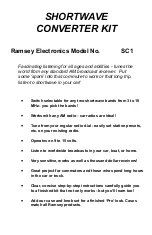
Page 13
Stealth DC-1 Stereo D/A Converter - Operator’s Manual
Hardware Configuration
Inserting or changing batteries in the remote control
The Stealth DC-1 remote control is opened by removing the two small screws in the
bottom end cap (the end without the LED).
Once the screws are removed, the end cap will come off, freeing the back plate to slide
out. Carefully slide the back plate all of the way out and remove it.
Insert two AAA batteries into the battery holder - observing proper polarity.
(We recommend alkaline batteries.)
Replace the cover, being careful to engage the edges in the slots in the side pieces, and
keep the end with the rubber pads towards the battery holder.
Replace the end cap and the screws.
Note: The remote control ships with batteries installed, but with a small
insulator strip between the batteries and battery terminal to prevent
discharge during shipping. Before using the remote control for the first time,
you must open the remote control and remove (pull out) the small insulator
strip between the end of one of the batteries and the battery terminal.
Note: The screws securing the end cap of the stealth DC-1 remote control are
tiny. A screw driver of the correct size is included with your DC-1.
Configuring the proper AC line voltage
The Stealth DC-1 can be configured to operate off either 115 VAC or 230 VAC
(+/- 10%). Operating voltage is selected using the red slide switch on the bottom panel
of the DC-1.
The number visible through the slot shows you the operating voltage currently
selected. Verify that the appropriate line voltage for your local area is currently
selected. If not, using a pointed object (like a screwdriver blade), reach through the
slot and slide the switch to the correct position.
Note: operating your DC-1 with the line Voltage selector in the wrong
position may result in permanent damage.
Configuring the headphone frequency response
By default, the headphone output of the Stealth DC-1 is configured to have a very
slight boost applied to the low bass (about 2 dB @ 20 Hz). This “bump” is common with
many headphone amplifiers and headphone outputs, and is intended to compensate
for the slight loss in very low bass encountered with many headphones. If you prefer
an absolutely flat headphone response, you may eliminate the bump by moving two
internal jumpers.
Содержание Stealth DC-1
Страница 1: ......
Страница 2: ......
Страница 6: ...Page 2 Stealth DC 1 Stereo D A Converter Operator s Manual...
Страница 30: ...Page 26 Stealth DC 1 Stereo D A Converter Operator s Manual...
Страница 31: ...Page 27 Stealth DC 1 Stereo D A Converter Operator s Manual...
Страница 32: ...131 SE Parkway Court Franklin TN 37064 www emotivapro com...
















































